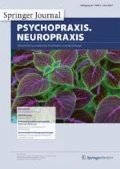Zusammenfassung
Suchterkrankungen und die Bewältigung ihrer Begleit- und Folgeerscheinungen stellen in unserer Gesellschaft zunehmend eine beträchtliche Herausforderung dar. Epidemiologische Studien zur Sucht liefern durchaus divergierende Ergebnisse, dennoch kann als realistische Annäherung angenommen werden, dass über 330.000 erwachsene Österreicher alkoholkrank sind. Rund 30.000 problematische Drogengebraucher werden vermutet, davon befindet sich mittlerweile ein großer Teil in Substitutionsbehandlung.
Dieser Artikel soll einen Einblick in die Praxis der niedrigschwelligen Suchthilfe geben, die sich mit ihren Leistungen vorrangig an opiatabhängige oder polytoxikoman substanzabhängige Menschen richtet. Deren Angebote sind geeignet, Kontakte zur Zielgruppe herzustellen, auch wenn diese zum gegebenen Zeitpunkt keine Veränderungsmotivation zeigen oder nicht in der Lage sind, den Substanzkonsum zu beenden. Die notwendige Kontinuität in der Anbindung an das Gesundheitswesen wird aufrechterhalten, um durch jederzeit mögliche Interventionen grundlegende Zielsetzungen der Überlebenshilfe und Schadensminderung zu erreichen. Die Vermittlung in weiterführende Behandlungs- und Therapieformen kann zum richtigen Zeitpunkt angesetzt werden. Das Angebot ist auf den Sozialraum bezogen, szenenah und akzeptanzorientiert. Die Erfahrungen dieses Praxisberichts stammen aus der langjährigen Tätigkeit von Kontaktladen und Streetwork im Drogenbereich, einer Einrichtung der Caritas Steiermark in Graz. Dieser Überblick dokumentiert die Möglichkeiten niedrigschwelliger Drogenarbeit, von denen auch junge Menschen während der Adoleszenz profitieren, und ergänzt diese mit Daten aus dem Jahresbericht des Kontaktladens von 2013.
Abstract
Addictions and the management of their side-effects offer a considerable challenge to our society. And though different studies show different results, we can realistically assume that more than 330,000 Austrians are alcoholics, the number of problematic drug-addicts being about 30,000, of which a growing number is making use of substitution treatment.
This article will provide some insight into the practice of low-threshold drug services, which are primarily responsible for opioid-dependent or polytoxikoman substance-dependent people. These services are suitable for the target group, even if they do not have the motivation for change and are unable to end substance use. The necessary continuity of access to healthcare is maintained to achieve the basic objectives of survival and harm reduction. Referral to further treatment and therapies can be applied at the right time. The services are based in the social environment, near the drug scene, and they are acceptance-oriented. The reported practical experiences emerge from the many years of work of Kontaktladen und Streetwork im Drogenbereich, an institution of Caritas Steiermark in Graz. This overview documents the possibilities of low-threshold drug work, from which adolescents benefit, and supplements these with data from the 2013 Kontaktladen annual report.


Notes
Im Rahmen der Bedarfsanalyse für ein Pilotprojekt „Konsumraum/Drogentherapeutische Anlaufstelle“ 2007.
Literatur
Currie C et al. (Hrsg) (2012) Social determinants of health and well-being among young people. Health behaviour in school-aged children (HBSC) study: international report from the 2009/2010 survey. Copenhagen, WHO Regional Office for Europe Health policy for children and adolescents, Bd. 6.
GÖG/ÖBIG, Epidemiologiebericht Drogen 2012/2013, Wissenschaftlicher Ergebnisbericht, Bundesministerium für Gesundheit
GÖG (2013) Report on the current state of play of the 2003, Council Recommendation on the prevention and reduction of health-related harm. European Commission, Vienna
Meili D, Dober S, Eyal E (2004) Jenseits des Abstinenzparadigmas – Ziele in der Suchttherapie. Suchttherapie 1:2–9
http://www.ihra.net/files/2010/06/01/Briefing_What_is_HR_German.pdf. Zugegriffen am: 15.12.2014
Caritas (2014) Jahresbericht Kontaktladen und Streetwork im Drogenbereich 2013, Graz: Caritas. http://streetwork.caritas-steiermark.at/downloads/
Author information
Authors and Affiliations
Corresponding author
Ethics declarations
Interessenkonflikt
R. Urban gibt an, dass kein Interessenkonflikt besteht.
Dieser Beitrag beinhaltet keine Studien an Menschen oder Tieren.
Additional information
Erstveröffentlichung in Pädiatrie & Pädologie (2015) 50:212–217. doi:10.1007/s00608-015-0288-x. Zweitpublikation mit freundlicher Genehmigung des Autors
Rights and permissions
About this article
Cite this article
Urban, R. Zugänge schaffen: Möglichkeiten niedrigschwelliger Drogenarbeit in der Adoleszenz. psychopraxis. neuropraxis 19, 82–87 (2016). https://doi.org/10.1007/s00739-016-0321-2
Published:
Issue Date:
DOI: https://doi.org/10.1007/s00739-016-0321-2

